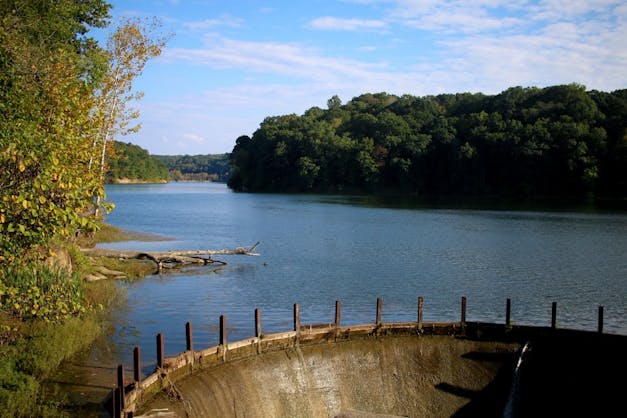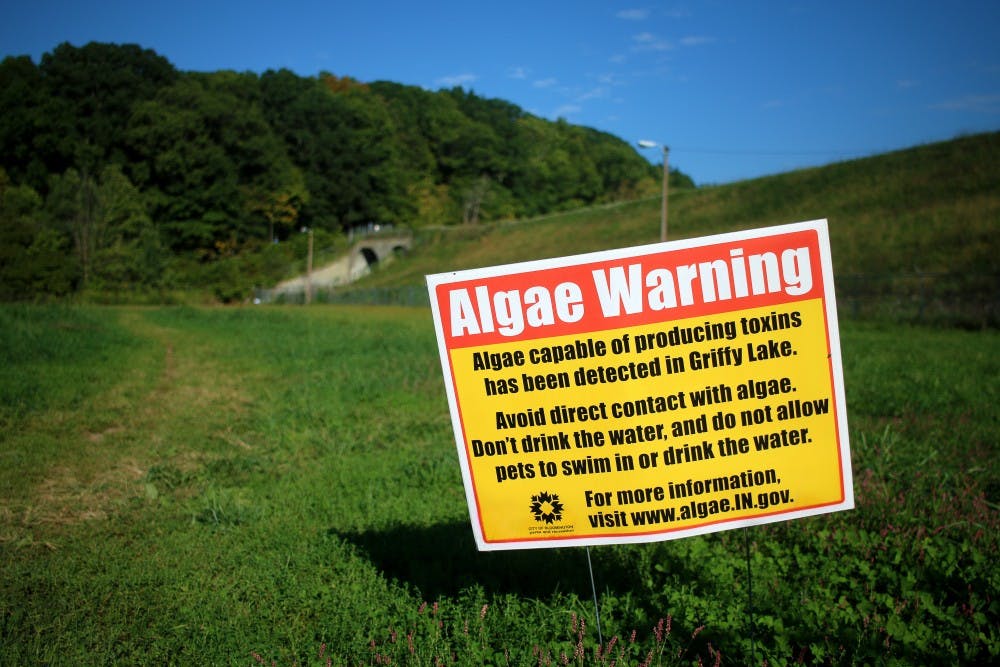Griffy Lake has a high quantity of blue-green algae, which may produce toxins that can negatively affect the skin and small animals.
The blue-green algae Oscillatoria was found in Griffy Lake on Sept. 21.
“I think most people might be concerned about a few handful of trouble making algae that ends up making harmful algal blooms,” said Melissa Laney, director of the Indiana Clean Lakes Program.
Laney said the presence of the blue-green algae itself is not harmful, but it becomes a problem when it reproduces at a rapid pace due to an abundance of nutrients. Nutrients can come in from runoff from fertilizers, golf courses and lawns. That phenomenon is known as an algal bloom. An algal bloom have not been recorded at the lake, but Laney said caution is always the best policy.

The Indiana Clean Lakes Program has not acknowledged if there is a bloom or not, Laney said.
The blue-green algae can cause dermal rashes if touched and will make dogs sick if ingested. They don’t know whether the algae is producing cyanotoxins that cause these symptoms because no toxin analysis has been done as of Oct. 8.
“The biggest nutrient of concern is phosphorous,” Laney said. “If you can control that, then you can control the density of rooted plants and plankton.”
The toxin is harmful to people and animals because it can get on the skin and cause rashes. With dogs, however, it can cause long-term problems. Fish are safe to eat because it does not build up in the skin, said Sarah Powers, limnology lab manager for the Indiana Clean Lakes Program.
According to a document produced by the Indiana State Department of Health, dogs that ingest large quantities of the algae can experience convulsions, seizures and vomiting.
Powers said the precautions to wash off with warm, soapy water and to keep animals away from the lake is a reiteration of the no-swim rule. She said pet owners should wash their animals soon after going into the water and not allow the animals to lick themselves.
Children and adults should not put the water in their mouths, which is a frequent reminder for her kids, Laney said.
“Kids seem to swim and play and recreate in water differently than an adult. There’s just always water in and out of their mouth,” Laney said. “It’s like, stop putting the lake water in your mouth.”
Ranjan Muthukrishnan, IU Environmental Resilience Institute fellow and research scientist, said algae is a bit of a catch-all term for anything weird in the plant kingdom, typically aquatic oddities. All algae is beneficial to ecosystems. The key is finding balance.
Powers said the blue-green algae is a photosynthetic bacteria, so it is different than typical algae. It is a cyanobacteria, because it mimics characteristics of algae and of bacteria. However, it poses no threat to the lake itself.
“Algae is very common in lakes,” Powers said. “It’s the basis of the food chain. Whenever the cyanobacteria grow to high concentrations in the lake, sometimes specific cyanobacteria can produce toxins.”
Not all algae can have harmful effects. Some people even eat algae without knowing it, such as seaweed, Muthukrishnan said.
“If you think of seaweed in the ocean, those are generally algae,” Muthukrishnan said. “If you ever had a seaweed salad, then you’re enjoying one of the benefits of algae.”
Laney said algal blooms occur more frequently with blue-green algae because of the advantages it has, such as blocking out light for rooted plants and access to sunlight.
“If we went out and sampled the lake right now, it would probably be 95 to 99 percent dominated by types of cyanobacteria,” Laney said.
One well-known algal bloom is found in the Gulf of Mexico, due to runoff going into the rivers that feed into the Gulf. Overconsumption of oxygen by algal blooms can interrupt ecosystems because there is not equal access to the oxygen, Muthukrishnan said.
Powers said she doesn't want the presence of the algae to scare off any potential visitors. The warning is to inform citizens and make sure the lake is usable for everyone.
“It’s a wonderful resource that we have available to us, so close to campus, to IU, for students and for the public,” Powers said.




